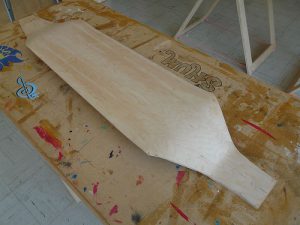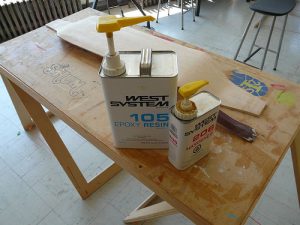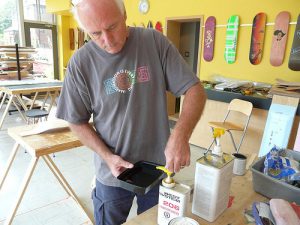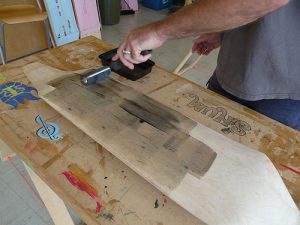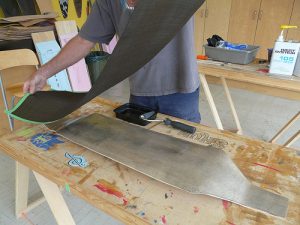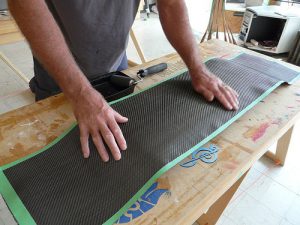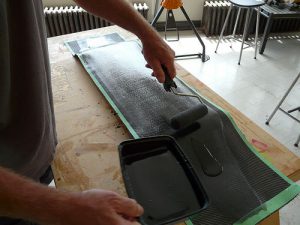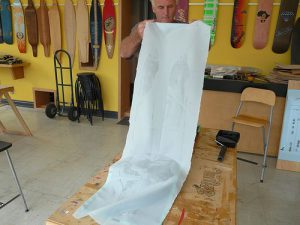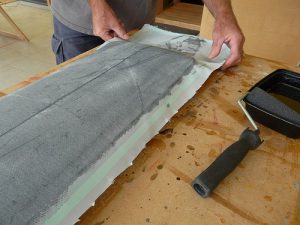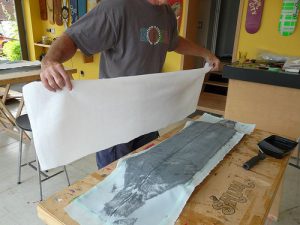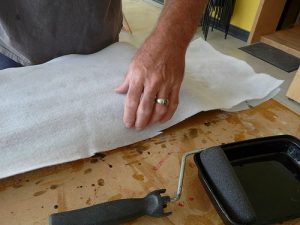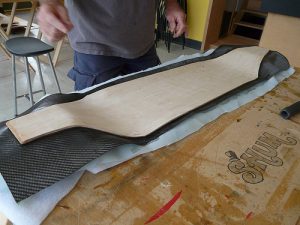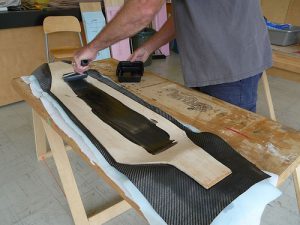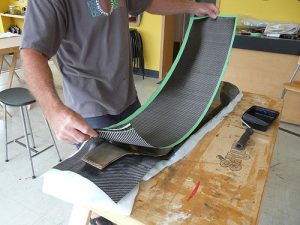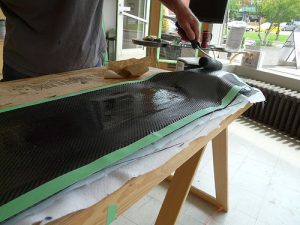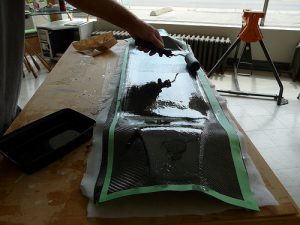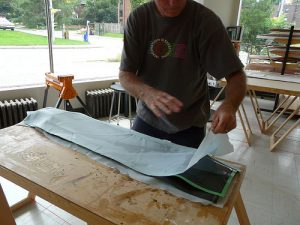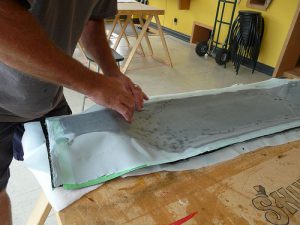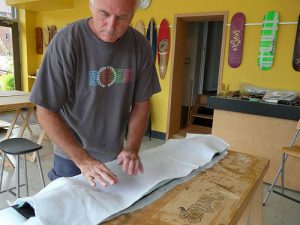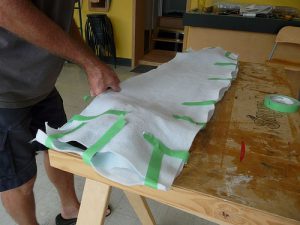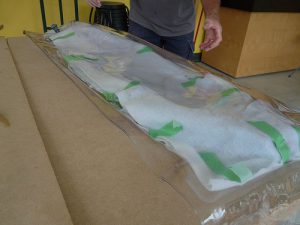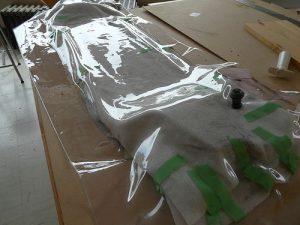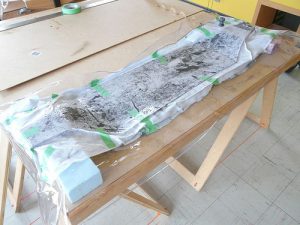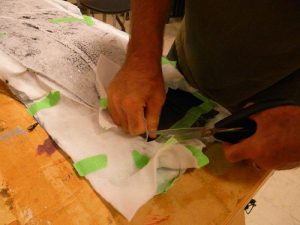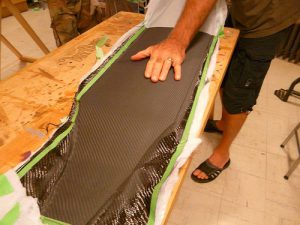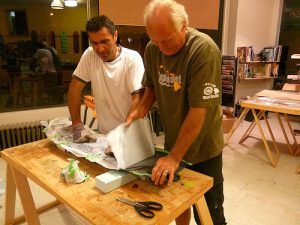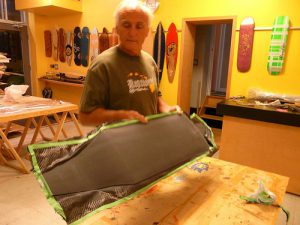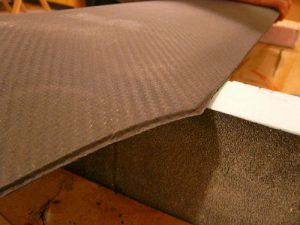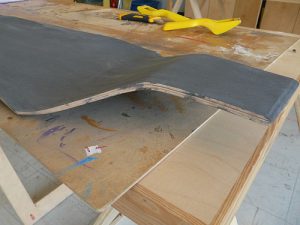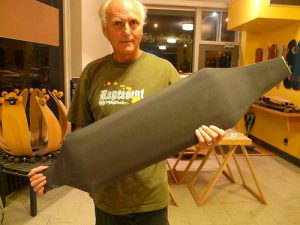This tutorial goes through in detail, the steps to laminate carbon fiber onto the top and bottom of a skateboard deck. Please check out Cutting Carbon Fiber if you are not familiar with cutting this material before starting this tutorial.
TOOLS NEEDED:
Foam Roller (Home Depot, Lowe’s)
Masking tape, paper towels, rubber gloves, sharp utility knife, mixing stick and tray
MATERIALS NEEDED :
From Supplier:
- Carbon Cloth
- Release Film
- Breather Ply
- 2-Part Epoxy (with pumps)
THE TUTORIAL :
I am going to laminate two layers of carbon cloth, one on top and one on the bottom of a PINCHed drop board. The deck has to be sanded smooth (150 sandpaper) with no bumps or ragged edges. Below is the prepped deck. I have left all the edges sharp and not rounded.
PRE-CUT YOUR MATERIAL : 
Pre-cut all the materials first.
This includes the:
- 2 pieces of carbon cloth
- 2 layers of release ply
- 2 layers of breather ply
THE PREPARATION :
You need to have your epoxy, Thin Air Press and
masking tape on hand ready to use. Making sure
everything is ready is a must when working with
composites.
THE EPOXY :
I am using West System epoxy. It is a general duty epoxy and will work fine for this type of laminating. I use 105 resin and 206 hardener. The hardener begins to set in around 45 minutes depending on the air temperature.
When epoxy is in mass, it heats faster than when it is spread thinly, so apply it to your project as quickly as possible. Do not let it sit for long in the mixing pot! Epoxy has to be measured properly, too much hardener and it will heat too quickly. Too little hardener and it will not set properly. The pumps are a good idea as they measure the epoxy precisely.
THE GLUE UP PROCESS :
To begin with, I used 8 pumps from each container and mixed them together for at about 60 seconds.
Using the roller, apply an even layer of epoxy onto the bottom surface of your deck. I have added carbon powder to the epoxy which turns the epoxy black. This is not necessary but it helps to prevent the wood colour from showing through the composite. I would not normally use it for most work as it dulls down the nice looking shiny carbon cloth.
Lay the carbon fiber cloth onto the wetted deck. Try to keep it as straight as possible, lengthwise to the deck. An extra set of hands is helpful with this.
Flatten the carbon to the deck and use the roller to get the air bubbles out of the material.
Apply an even coat of epoxy over top of the deck. Wet it out completely.
Lay the layer of release film onto the wet carbon cloth. Try to keep it straight.
Press the material down until it conforms to the shape of the deck. Again, use the roller to get the air bubbles out. Pull any wrinkles straight. It is a good idea to wear rubber gloves (unlike what you see me doing).
Lay the breather ply down. Pat it down so it conforms to the deck surface.
Carefully flip the deck over. Try not to shift the carbon layer.
Apply an even coat of epoxy onto the entire deck.
Lay the second piece of carbon cloth onto the wet deck.
Evenly wet out the carbon cloth with the roller.
Lay the release film down and flatten it to the deck with the roller.
Pat it down flat.
Lay the last layer of breather ply down.
Using masking tape, apply pieces around the deck, taping every 6-8 inches as shown. This will hold the loose material together when putting it in the TAP bag.
Place the deck into the TAP bag. One way of doing this is to open the bag fully by blowing air into it with a vacuum cleaner. While standing on a chair, carefully lower your project from above into the bag which the other person holds open.
Keep your hands clean during this step. Do not get epoxy on the sealing tape or close to the opening of the TAP bag as the sealing tape will not stick properly if even a small amount of epoxy gets on it. Use plain white vinegar to clean your hands (not the bag), it removes epoxy really well!
Seal your TAP bag. Use the vacuum cleaner to evacuate the bulk of the air then use the manual pump to pull the remaining air out. Be sure to position the valve off the deck but over the breather ply right beside the deck. This ensures that the air can get out but will not make a mark on the top of your smooth carbon area.
This is what it should look like once the air has been removed.
In a couple of minutes, check to see if the vacuum is still holding tightly. If any air has leaked in, check and re-press the sealing tape first.
The epoxy will start to harden in a couple of hours. Leave your project in the bag for at least 8 hours.
REMOVING THE EXCESS MATERIAL :
You will need to peel away the release film and breather ply after removing your project from the TAP bag. This take a fair amount of pulling, and sometimes cutting along the edge of the deck.
Looking good!
CLEAN UP THE EDGES :
It is time to clean up the edges of the deck. A sharp utility knife works great. The epoxy/carbon cloth it is very sharp. Be careful!
Trim as close to the edge of the deck as possible.
Using a file or coarse sandpaper with a sanding block, remove the remaining carbon to the edge of the deck.
It should look something like this when done.
On the bottom, I later added a pre-preg carbon layer. I made this by laminating it on a sheet of glass.
That is about all you need to know to laminating carbon fiber to a deck! Most of the work is in cutting the material and getting everything prepped.
Ted Hunter


